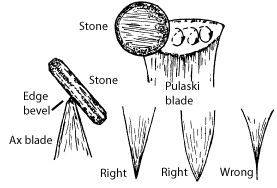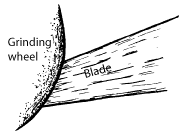Tools for Sharpening

Dull tools are useless and dangerous.
A tool need not be old and worn to need sharpening. Many tools arrive dull from the factory. They may leave in good condition but become damaged during shipping. Inspect all tools before use. Sharpening makes tools last longer—a small scratch that is ignored could lead to a serious crack or nick in the blade.
Use a material like a file or grindstone that is harder than tool steel to remove metal from the edge. If there are no visible nicks, a touch-up with a whetstone will restore a keen cutting edge. In these instances, you need only restore the edge bevel. Whetting the edge removes very small bits of metal from the blade and causes the remaining metal to burr slightly on the cutting edge. This burr is called a feather, or wire edge. Remove this weak strip by honing the edge on the other side. The correctly honed edge is sharp, has no wire edge, and does not reflect light or show a sharpening line. Wear gloves when sharpening cutting edges.

When sharpening an ax or Pulaski blade, for example,
work the stone in
small circles across and "into" the blade.

A wire edge is removed by honing
the opposite edge.
Restoring the blade bevel requires coarser grinding tools to affect the shape of worn cutting blades. Reshape blades with hand files, sandstone wheels, or electric grinders. Remove visible nicks by grinding the metal back on the blade. Remember, however, that the correct blade bevel must be maintained. Remove the metal necessary to make the blade smooth while retaining its proper shape. If the shape is too radically affected, either have a blacksmith recondition the tool head or discard the tool.
The Missoula Technology and Development Center has developed a handtool sharpening gauge that provides a quick guide to the proper cutting angle for a number of tools. The gauge takes the guesswork out of sharpening Pulaskis (both ends), axes, shovels, combination tools, and McLeods. It has a "no-go" line that shows when a Pulaski head is too worn to refurbish. The handtool sharpening gauge is available from the General Services Administration, item number: NSN 5210-01-324-2776, NFES 0510.



The handtool sharpening gauge is a handy aid for
inspecting and sharpening
a variety of fire handtools.
Files come in single, double, curved, or rasp cuts. Single-cut files have one series of parallel teeth angled 60° to 80° from the edge, and are used for finishing work. Double cuts have two series of parallel teeth set 45° to each other; they are used for restoring shape. Curved and rasp cuts are used for shaping soft metals and wood, respectively.

This file has a knuckle guard made
from old linen hose.
Files vary in length and shape. Files are measured from the point to the heel, excluding the tang (the tip used to attach a handle). Length determines the coarseness of files. There are generally three degrees of file coarseness: bastard, second cut, and smooth. The bastard will be the coarsest file available, however, only when it is included among different cuts of files of the same length. Of the many shapes of files currently on the market, you will probably not often use mill and flat files. Mill files are single-cut, and flat files are double-cut. A 10-inch mill bastard file is good for all-around tool sharpening.


Comparative coarseness of
files of uniform length.
Before filing, fit the file with a handle and knuckle guard. Always wear gloves on both hands to prevent cuts from the sharpened edge. Secure the tool so both hands are free for filing. Use the largest file you can, depending on the size, nature, and workable stroke length of the job. Remember that files are designed to cut in one direction only. Apply even pressure on the push stroke, then lift the file up and off the tool while returning for another pass. Store or transport files so they are not thrown together and protect them from other tools.
Maintain files with a brush or file card. A file brush has coarse and fine bristles and a wire pick for extracting trapped filings. A card has a small brush and a wire scorer.

Always wear gloves and goggles while filing.
A manually operated sandstone wheel that runs through or receives dripping water is the best all-round grinding tool. The wheel turns slowly enough to allow monitoring of the amount of metal being removed and the water keeps the blade cool. For volume sharpening, a sandstone wheel may be provided with mechanical power, but only if it remains geared to the same maximum revolutions per minute that a hand operation would allow.
Electric bench grinders quickly reshape damaged tools, but extreme caution must accompany their use. Improper electric grinding can ruin both the bevel and temper of a tool. High speeds remove metal from the blade quickly, which can cause it to weaken and chip easily. High speeds also allow heat buildup in tool heads, which can destroy temper and make it impossible for the blade to hold an edge. Using electric grinders, grind slowly and keep the blade cool. Inspect blades frequently to prevent too much metal from being ground from the blade. Dip the tool in water or cool it in open air. Avoid grinding on flat sides of electric wheels because they will weaken and break.

Grinding parallel to bevels maintains the correct angle.

Sharpening a blade on
a grinding wheel.
Finish the edge with a whetstone as if you were touching up. Blade and edge bevels may vary with individual preference and based on the task at hand. When sharpening an ax, for example, the blade bevel for use in softwoods might be thinner than one for hardwoods. Experience, observation, and experimentation will determine the appropriate bevels for each tool and cutting job.
Use adequate safety equipment when grinding tools. Always wear heavy leather gloves. Long-sleeved shirts and leather aprons will help prevent small burns from sparks or metal shavings. Proper eye protection is essential, including eye shields or safety goggles for operators and shields and hood guards on grinders. Hold portable grinders securely when using.
Use whetstones to finish sharpened cutting edges or when touching up edges in the field. Whetstones are natural or manmade. We recommend synthetic abrasives for sharpening tools because they are harder than natural stones, the uniform honing particles assure an even sharpening surface, and they cost less than natural stones. If you prefer finishing with a natural stone, use a synthetic stone first. This produces a very sharp edge and saves expensive natural stones from unnecessary wear on rough work.
Most whetstone manufacturers soak new stones in light oil. You may also apply oil to the stone's surface before honing to float off pieces of metal and grit and prevent them from lodging in the stone's pores. If the stone glazes because the pores fill with shavings, clean it with citrus-based solvent and a stiff brush.
When whetting, use the entire stone surface to maintain its shape. Rotate the stone periodically to ensure even wear. If the surface becomes uneven, it may be reshaped by rubbing it over a sheet of glass sprinkled with carborundum powder or on a sheet of coarse sandpaper. Keep stone surfaces wet while reshaping them.



